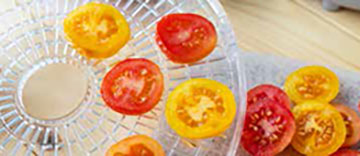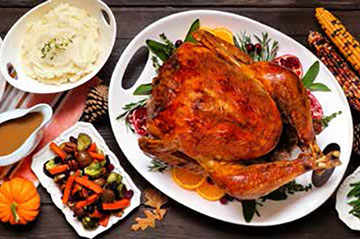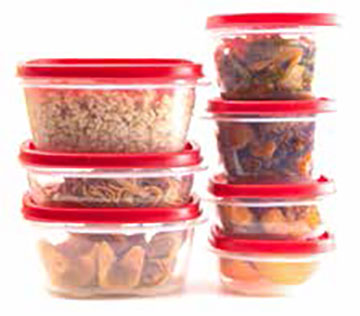
Give Yourself a Gift That Inspires Your Menus
 We often think of food preservation as “seasonal.”
We often think of food preservation as “seasonal.”
“The tomatoes are ripe; it’s time to can them!”
If you have an excess of high-quality fruits or vegetables, consider canning, drying or freezing them. Food preservation can happen all year—and with today’s appliances, it can also be easier, safer, and more fun. Treat yourself to a tool that inspires creativity in the kitchen, such as a food dehydrator, an electric water-bath canner, or an electric pressure canner.
- Dry food. Food dehydrators can be used to make dried fruits or vegetables, leathers and jerky, usually at a lower price than commercial snacks. Many types of dehydrators, which vary in size and price, are available.
- Choose a dehydrator that allows temperatures between 85° F and 160° F.
- A two-speed fan with horizontal air flow is recommended.
- For fruit leathers, look for trays with ¼- to ½-inch raised edges.
- Safety features such as a grounded cord and UL certification are important.
- And of course—read the directions before starting!
Can food all year.
From jams and sauces to soups and more, research-tested recipes make it possible to preserve nearly anything.
- Electric canners are popular because they automate the process and keep kitchens cooler.
- Many electric water-bath canners include a spigot for easy draining and sit conveniently on the countertop—no heavy lifting required.
- Look for trusted brand names that are easy to use and clean.
- Always label jars with the contents and date, and aim to use home-canned goods within a year for best quality.
For more trusted tips, check out the North Central Food Safety Extension Network’s food preservation resources, developed by Extension professionals from 12 Midwest states.
Holiday Leftovers: Freezing Tips
 The holiday season is a busy time filled with gatherings and many of our favorite holiday foods. While we enjoy our holiday meals, we often find ourselves with more leftovers than we can handle. Freezing is one of the easiest ways to preserve leftovers! Freeze leftovers you won’t eat to avoid food waste, save money and time on future meals, and enjoy those favorite foods longer. Follow these tips to freeze your leftovers this holiday season.
The holiday season is a busy time filled with gatherings and many of our favorite holiday foods. While we enjoy our holiday meals, we often find ourselves with more leftovers than we can handle. Freezing is one of the easiest ways to preserve leftovers! Freeze leftovers you won’t eat to avoid food waste, save money and time on future meals, and enjoy those favorite foods longer. Follow these tips to freeze your leftovers this holiday season.
- Plan how to use your leftovers: Remember, you can make a new dish with your leftovers such as turkey casserole, turkey soup, ham soup, ham and egg bake, and stuffing or mac and cheese muffins. These new dishes can also be frozen for an easy meal another night.
- Cool your food before freezing: Allow food to cool slightly at room temperature and refrigerate within 2 hours. Place food in smaller containers to help the food cool quickly. Once cooled move it to the freezer.
- Choose the right container: Choose freezer-safe, air-tight, moisture-resistant, durable and leakproof containers. This will help protect the food’s flavor and quality. Good options include freezer-friendly zip top bags, plastic or glass containers, or plastic/paper freezer wrap.
- Choose foods that freeze well: Turkey, ham, and other meats are great options for freezing. When freezing soups and gravy, leave at least 1 inch headspace between the food and top of the container to allow for expansion. Pies, cookies, and dessert bars can be frozen. While casseroles are a good option for the freezer, those with a lot of vegetables may get watery once they thaw due to the vegetables’ water content. Mashed potatoes can be frozen but be aware that the texture may change once they thaw. Foods that contain mayonnaise or milk sauces can separate after thawing.
- Label and date: Label the package with the name of the food and the date it was placed in the freezer. Other helpful information could include any ingredients, number of servings, and directions for cooking once thawed.
- Keep the freezer cold: Ideal freezer temperature is 0°F. Avoid overfilling your freezer as this can raise the temperature and make it hard for your freezer to cool properly.
 Store frozen food: Generally, frozen leftovers can be stored for 3-4 months. However, for the best quality, use shorter storage times. After 3-4 months, the food is still safe to eat, it may just lower in quality.
Store frozen food: Generally, frozen leftovers can be stored for 3-4 months. However, for the best quality, use shorter storage times. After 3-4 months, the food is still safe to eat, it may just lower in quality.